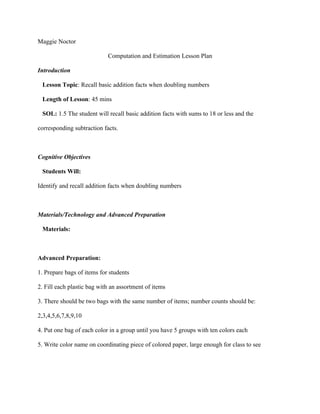
Maggie Noctor Lesson on Doubling Numbers
- 1. Maggie Noctor Computation and Estimation Lesson Plan Introduction Lesson Topic: Recall basic addition facts when doubling numbers Length of Lesson: 45 mins SOL: 1.5 The student will recall basic addition facts with sums to 18 or less and the corresponding subtraction facts. Cognitive Objectives Students Will: Identify and recall addition facts when doubling numbers Materials/Technology and Advanced Preparation Materials: Advanced Preparation: 1. Prepare bags of items for students 2. Fill each plastic bag with an assortment of items 3. There should be two bags with the same number of items; number counts should be: 2,3,4,5,6,7,8,9,10 4. Put one bag of each color in a group until you have 5 groups with ten colors each 5. Write color name on coordinating piece of colored paper, large enough for class to see
- 2. Teaching and Learning Sequence Introduction/Anticipatory Set: • Ask student what doubling means to them. • Write student responses on board. • Take out jumbo die and call on one student to volunteer to roll the die. • Have student come up front and roll the die. • Have student tell class what number appeared, teacher writes number on the board. • Have the students write this number down on their paper. Ask students to double this number by writing an equation. • Then ask all students what equation they came up with, write equation on the board. • Then have all students solve this equation; they may use counters or a number line if necessary. Write answer on the board in numerical order. • Repeat this procedure until all numbers 1-6 have been written on the board. Lesson Development: • Talk with student about what they have just done. • They have doubled all the numbers from 1-6 on the board. • Ask students if they see any patterns or anything that is the similar to all the sums now written on the board. • See if the students notice all the sums are even, that all the sums are only 2 numbers a part. • Discuss how these patterns may help or be an easier way to figure out other numbers once we know our doubles. Ex. After you double 4+4=8, you know that 5+5 is only two more then 8, so should be 10 or 5 is 1 more than 4, so 1+1=2, 2+8=10.
- 3. • After you have discussed double patterns with students. Continue the doubles on the board by going from 6 to 10 doubling. • Erase the board • Have students break into groups of 2. • Give each pair of students two dice. • Have students take turns rolling and writing down the doubles equations that appear on the dice. Students may choose to add the showing numbers together and then double that number, or to just choose one of the numbers showing and double that number. • Students should take about 4 rolls each, then use the equations on their sheets to write the equations for the other doubles that were not rolled. Closure: • Have students break into groups of 2. • Give each pair of students two dice. • Have students take turns rolling and writing down the doubles equations that appear on the dice. Students may choose to add the showing numbers together and then double that number, or to just choose one of the numbers showing and double that number. • Students should take about 4 rolls each, then use the equations on their sheets to write the equations for the other doubles that were not rolled. • After they have written the numbers for the doubles they have not rolled, students should write addition sentences for each number 1-10 doubling the number. • Review the answers and equations that should be written. Homework: None
- 4. Assessment: Formative: • Listen to answers given during the review of colors used in the book The Deep Blue Sea. Are the students naming actual colors from the book or can they not recall any? • Watch while students create their Play-Doh model; are they using the correct color as read from the book? Do they look confused or wait to choose their color after a classmate has helped? Summative: • Have students at end of the lesson name the name of the colors as a class while holding up the colored piece of construction paper with color name label on it, watch for students who still look confused. • For the next eight days review color names by having a day designated for that color, students should wear the corresponding color or bring in an object from home each day that shows the color of the day. When taking roll place a check by the students name if they have completed the task or showed understanding by wearing or bringing the correct color. References: Molly, Vasquez. (2010-1996). Doubling Numbers. http://www.lessonplanspage.com/MathDoublingNumbersWithGiantDie1.htm.